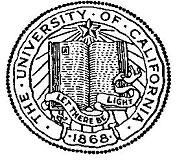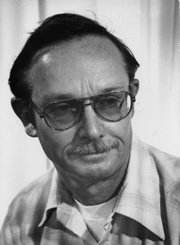

|

|
IN MEMORIAM
David L. Jones
Professor of Geology, Emeritus
UC Berkeley
1930 – 2007
David L. (“Davy”) Jones, geologist at the U.S. Geological Survey from 1955 to 1985 and professor of geology at the University of California, Berkeley, from 1985 to 1996, passed away on October 30, 2007, at his home near Placerville after a long struggle with cancer. Professor Jones is survived by his wife Jeanne, by four children, daughter Rebecca Granger and her husband David; daughter Susan Vincent and her husband Christopher; son Thomas and his wife Beth; son Charles and his wife Noreen; and by 16 grandchildren.
Professor Jones was born in Chicago on November 12, 1930, and grew up in Michigan. After undergraduate work in geology at Yale University, he received his Ph.D. at Stanford University in 1956 and went to work at the U.S. Geological Survey in Menlo Park as a research geologist and paleontologist. Over the next 30 years at the Survey and then for another decade at UC Berkeley, while the plate-tectonic paradigm change was revolutionizing scientific understanding of the Earth, Jones made fundamental contributions to the understanding of the geologic history and tectonic evolution of the mountain system of western North America that geologists call the Cordillera, contributions that greatly expanded and sharpened the original scope of plate tectonics.
Within the Cordillera, the geological character of the California Coast Ranges is particularly difficult to understand because of the rarity of fossils useful for dating the rocks and because of the intense deformation that has produced thoroughly scrambled mixtures of rocks that geologists call “mélange.” The first major breakthrough in understanding the Coast Ranges came with a paper by Bailey, Irwin, and Jones in 1964, in which Jones provided the paleontological age information on the rare fossils that had been collected. As the plate-tectonic revolution gathered steam through the 1960s, the Bailey-Irwin-Jones paper provided the key to recognizing that the California Coast Ranges had been produced at a plate margin where oceanic crust had been subducted beneath North America. In this now widely-accepted model, the Coast Ranges consist mostly of rock units that have been accreted onto the continental margin during the subduction process, somewhat akin to the action of a snowplow.
Plate tectonics was originally a theory of very large rigid caps called plates, each comprising part of the 100-km-thick outer shell of the Earth (the lithosphere) and moving relative to the other plates. The North American Plate, for example, comprises almost all of the continent of North America and half of the Atlantic Ocean east of it. Working in Alaska, however, Jones and his colleagues soon recognized evidence that very much smaller blocks of continental crust have moved around independently, migrated out of the Pacific Ocean, and become incorporated in the Cordillera. They began to call these units “terranes,” and on the basis of detailed fieldwork in remote parts of Alaska they recognized many different terranes, each with its own unique geological history recorded in its rock sequence. At first this view of Cordilleran tectonic complexity seemed to contradict the concepts of plate tectonics, and for a while the units were called “suspect terranes.” But the evidence became overwhelming, and eventually the terrane concept was adopted by geologists in many other parts of the world to explain the tectonic complexity of other mountain belts. It is now one of the key tools for interpreting the history of the Earth’s surface, although some still dispute either the concept itself, or argue that the model has been overused in interpreting Cordilleran geology. Professor Jones did not entirely discount the possible weaknesses of the terrane concept, but instead rather enjoyed any good intellectual joust on the subject. (For a justification of the odd spelling of terrane, see the surprisingly popular account, Annals of the Former World, by John McPhee, who explains on page 10 that geologists have long used “terrain” for landscape and “terrane” for “a large chunk of the Earth.”)
Meanwhile Emile Pessagno at the University of Texas at Dallas invented a technique for extracting the microscopic fossils called radiolarians from their very hard matrix, a rock made of SiO2 and called chert, by partially dissolving the rock in hydrofluoric acid. Radiolarian chert is very abundant in the California Coast Ranges and the Canadian and Alaskan parts of the Cordillera, where other fossils are vanishingly rare. Prior to the Pessagno technique, the radiolarians were impossible to extract, identify or date, but the new technique made it possible to identify the microfossils and thus to date the cherts. Davy Jones quickly developed this technique and built a laboratory that could process and date a large number of samples. Geologists from all over the Cordillera and elsewhere sent their cherts to Jones, and microfossils from these previously intractable rocks provided the chronological information that fleshed out the terrane concept and thus unlocked the tectonic history of the Cordillera. Simultaneously, Jones and many other colleagues around the world established a radiolarian biostratigraphy that has proven invaluable in many diverse geological contexts, advancing not only our understanding of global geological processes, but of evolutionary biology as well.
After moving to UC Berkeley, Professor Jones made further contributions to understanding the geologic evolution of the Cordillera. With his Berkeley colleagues Mark Richards and Donald DePaolo, and with Robert Duncan, he showed that the most enigmatic of the Alaskan terranes originally identified by Jones and his coworkers, the Wrangellia terrane, was formed by the eruption of enormous piles of basalt several kilometers thick, derived from a giant mantle plume. Moreover, this pile of “flood basalts” was sandwiched between complete sedimentary sequences that reveal the uplift and subsidence history associated with the arrival of the plume beneath the lithosphere and crust. During this period Jones also showed that the history of the California Coast Ranges involved large-scale extension and thinning, paradoxically related to the well-known compression and thickening. And with colleagues from UC Berkeley and the U.S. Geological Survey he carried out extensive and detailed geologic mapping of the Bay Area that provides critical information relevant to earthquake risk. Professor Jones’s contributions to geology were honored with the Mary Clark Thompson Medal of the National Academy of Sciences in 1995.
At the same time that he moved to UC Berkeley, Jones and his family established a winery near Placerville, and they began producing highly regarded wines with the appropriately geological name “Lava Cap.” (Lava Cap is an old miners’ term for a resistant volcanic rock layer that overlies, or “caps” the famous gold-bearing gravels of the Sierra Nevada foothills that spawned the 1849 California Gold Rush.) In 1996, Professor Jones retired from active teaching and moved to his winery to devote himself to his two great loves, geological research and winemaking. He will be remembered by his colleagues both at Berkeley and at Menlo Park for his passion for geology, his strong and forcefully-expressed scientific opinions, for his central role in the evolution of the simple theory of plate tectonics into a more complex and subtle theory capable of explaining the geological details actually observed in the field, and for his fundamental contributions to understanding the tectonic history of western North America.
Walter Alvarez
Mark Richards